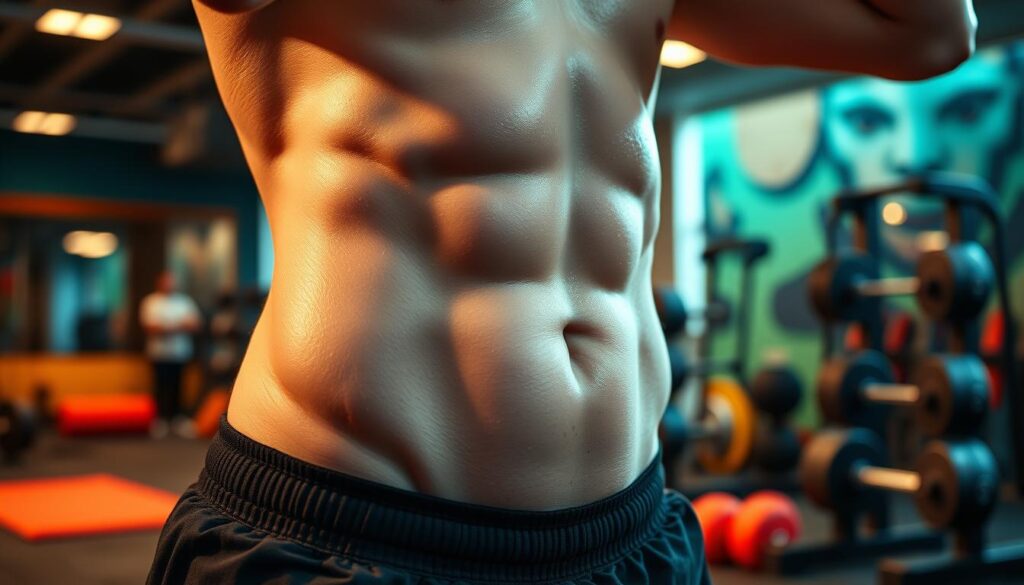Many Americans are searching for a way to get a flat stomach. They spend a lot of money on products and programs that promise to “burn belly fat.” But, there’s no quick fix for losing weight. You need a plan that includes exercise, eating right, and changing your lifestyle.
Sweating is linked to working out and losing weight. But, sweating itself doesn’t burn belly fat. Yet, sweating can happen when you do exercises that help you lose weight, like those for your stomach. This guide will help you understand how sweating and fat loss are connected. We’ll also clear up some myths and give you a complete plan for losing weight.
Key Takeaways
- Sweating is not a direct way to burn belly fat, but it’s associated with physical activity that can contribute to overall weight loss.
- Effective weight loss requires a combination of exercise, a balanced diet, and lifestyle changes, not just sweating alone.
- Exercise intensity, rather than the mode of exercise, plays a significant role in weight loss.
- Proper hydration and sleep are crucial for optimal exercise performance and fat-burning.
- Incorporating a variety of exercises, including cardio and strength training, can help you achieve your weight loss goals.
Understanding the Science Behind Sweating and Fat Loss
Many think sweating is key to losing belly fat. But, the science is more complex. Sweating helps control body temperature, but it doesn’t directly burn fat.
The Role of Sweat in Body Temperature Regulation
Sweating helps your body cool down. When you exercise, your body gets hotter. Sweat evaporates to cool you down.
This keeps your body temperature healthy. But, it doesn’t burn fat.
Differentiating Between Water Loss and Fat Loss
Weight loss from sweating is mostly water. You lose water weight, but it comes back when you drink water. True fat loss needs a calorie deficit over time.
How Your Body’s Cooling System Works
Your body has a cooling system. It uses sweat glands, blood vessels, and sweat evaporation. When you get hot, your brain tells your sweat glands to work.
This helps cool you down. It keeps your body balanced and safe from heat sickness.
Remember, sweating is natural but doesn’t mean you’re losing fat. To lose belly fat, eat right and exercise regularly. Include cardio and strength training.
“Sweating is not a reliable indicator of fat loss. The key to reducing belly fat is to create a calorie deficit through a combination of a healthy diet and regular physical activity.”
Types of Body Fat and Their Impact on Health
It’s important to know about the different body fats and their health effects. There are two main types: subcutaneous fat and visceral fat.
Subcutaneous fat is the fat under your skin. It keeps you warm, stores energy, and protects your muscles and bones. About 80% of healthy people’s fat is in this area. This fat is less harmful than visceral fat.
Visceral fat wraps around your organs like the liver and heart. Too much of it can raise your risk of diabetes, heart disease, cancer, and fatty liver disease. It’s also called “belly fat” and is linked to metabolic problems.
Visceral fat can build up from eating too much fat and carbs, not exercising, and being stressed. Your genes and environment also affect where and how much fat you have.
| Fat Type | Location | Health Impacts |
|---|---|---|
| Subcutaneous Fat | Under the skin | Insulation, energy storage, muscle and bone protection |
| Visceral Fat | Surrounding internal organs | Increased risk of diabetes, heart disease, cancer, fatty liver disease |
Checking your body fat is key for staying healthy. Measuring your waist is a simple way to guess your visceral fat. But, scans like CT or MRI give a clearer picture.
For any body fat, eating right, exercising, and taking care of your health is important. This helps manage fat and keeps you well for a long time.
Does Sweating Burn Belly Fat: The Truth Revealed
Many think sweating alone can melt belly fat. But, it’s not that simple. Sweating shows you’re working hard, but it doesn’t mean you’re losing fat, especially in your belly.
Common Misconceptions About Sweat and Weight Loss
Some believe sweating means they’re burning fat. But, it’s not true. Sweating helps your body cool down. It depends on how hard you’re working out, the weather, and your body.
People spend a lot of money on weight loss products. This shows they think there’s a quick way to lose belly fat.
Scientific Evidence and Expert Opinions
Studies say losing weight, including belly fat, needs a balanced plan. You must burn more calories than you eat. Sweating helps you lose water and salts, not fat.
Experts say a healthy lifestyle is key. This includes:
- Doing both cardio and strength training to boost your metabolism and build muscle
- Eating a diet rich in nutrients but low in calories to support your weight loss
- Getting enough sleep and managing stress, as they both affect your weight
Sweating is a sign of hard work, but it’s not a direct fat loss indicator. Real weight loss comes from a whole lifestyle change. Quick fixes won’t help you keep the fat off for good.
The Connection Between Exercise Intensity and Sweating
Many think sweating more means burning more fat. But, it’s not that simple. How hard you exercise is key to burning calories, not just sweat.
Sweating helps keep your body cool, not just burn fat. Too much sweat can make you dehydrated. Signs of dehydration include feeling confused, fainting, and not peeing much.
How much water you need depends on your age and sex. Sweating does burn calories, but those calories go to sweat glands, not fat. Exercise intensity really burns fat.
To lose fat, focus on how hard you work out, not just sweat. Do exercises that make your heart rate and breathing go up. The “talk test” helps check if you’re working hard enough.
| Exercise Intensity | Calorie Burn | Sweat Production |
|---|---|---|
| Moderate | Moderate | Moderate |
| Vigorous | High | High |
| Low | Low | Low |
Sweating is good when you exercise. But, it’s not the only thing that makes a workout good. Try different sweaty workouts and fat burning exercises to keep your heart rate up and feel good.

Effective Workouts for Maximum Fat Burning Results
To lose belly fat, mix cardio and strength training. Add different fat-burning exercises to your routine. This way, you’ll lose weight and feel good about it.
Cardio vs Strength Training for Fat Loss
Cardio like running, cycling, and swimming burns calories and boosts your metabolism. An 83kg (185lbs) man can burn about 336 calories in 30 minutes of running, Harvard Health says. For more calories burned, try the SkiErg, which can burn 399 calories in 30 minutes for the same person.
Strength training builds muscle, which raises your resting metabolic rate. Exercises like sled pushing, kettlebell swings, and mountain climbers are great for losing fat. They mix strength training with high-intensity cardio.
Optimal Exercise Duration and Frequency
To lose weight, aim for 150 minutes of moderate or 75 minutes of vigorous exercise weekly. But for more fat burning, do 225-420 minutes of exercise. Find a balance between cardio and strength that fits your fitness level and goals.
| Exercise Type | Calorie Burn (30 mins, 83kg/185lbs) |
|---|---|
| Running | 336 calories |
| SkiErg | 399 calories |
| Sled Pushing/Pulling | High-intensity, builds strength |
| Kettlebell Swings | Builds muscle, burns calories, enhances grip strength |
| Mountain Climbers | Highly effective calorie burner |
For the best fat burning, challenge your body with cardio and strength training. Stay consistent, listen to your body, and enjoy the journey to a leaner, healthier you.
Nutrition Strategies to Support Fat Loss Goals
To lose belly fat and burn fat, eating right is key. Eat foods that are full of nutrients and low in calories. Avoid foods that are high in calories but low in nutrients.
Eat more fiber, aiming for 14 grams for every 1,000 calories. Focus on whole grains, fruits, veggies, and lean proteins. Cut down on sugary drinks and foods that are high in calories but low in nutrients.
No single food targets belly fat. Losing weight overall will help reduce fat in your belly. A good plan includes eating well, exercising, and living a healthy lifestyle.
Here are some tips to help you eat better:
- Choose complex carbs for steady energy and feeling full.
- Add healthy fats like avocados, nuts, and fatty fish for hormone balance.
- Drink lots of water to stay hydrated and help burn fat.
- Don’t eat too much sugar to avoid insulin resistance and belly fat.
- Get help from a dietitian to make a meal plan that fits your needs.
Slow, steady changes are best for losing weight. These tips can help you reach your fat loss goals and improve your health.

“For previously sedentary individuals, a slow progression in physical activity should result in achieving 30 minutes of exercise daily after gradual build-up (Jakicic et al., 1999).”
| Nutrition Factor | Benefit for Fat Loss |
|---|---|
| Increased Fiber Intake | Promotes feelings of fullness, regulates blood sugar, and reduces the risk of type 2 diabetes and visceral fat accumulation. |
| Limiting Refined Carbs and Added Sugars | Helps prevent insulin resistance, inflammation, and excessive visceral fat storage. |
| Incorporating Healthy Fats | Supports hormone balance, which is crucial for metabolic function and fat burning. |
| Staying Hydrated | Maintains proper body temperature regulation and supports the body’s natural cooling and fat-burning processes. |
The Role of Hydration in Fat Loss and Exercise Performance
Drinking enough water is key for sweating during exercise, burning fat, and doing well in workouts. Our bodies are mostly water, which helps us break down fat for energy.
Water Intake Guidelines for Active Individuals
Experts say active people should drink about 9 cups (2.1 liters) of water a day if they’re female. Males should aim for 13 cups (3 liters). This helps replace lost water from excessive sweating during exercise. Drinking water also helps with weight loss by making you feel full and burning more calories.
Signs of Dehydration During Workouts
- Decreased urine output or dark yellow urine
- Dry mouth, lips, and eyes
- Headaches or dizziness
- Fatigue or muscle cramps
- Rapid heart rate
Not drinking enough water can hurt your fat burning and workout performance. It’s important to drink water before, during, and after working out. This keeps your body hydrated and helps with fat loss.
“Drinking water before meals can lead to a feeling of fullness, reducing hunger and supporting weight loss efforts.”
Staying hydrated is not just for your workouts. It’s also important for your health and fat loss journey. Add these hydration tips to your daily routine and see the good changes.
Sleep and Stress Management for Enhanced Fat Loss
Getting your belly fat reduction goals right is more than just working out and eating right. Good sleep and managing stress are key to losing weight and burning fat through sweating.
Getting 7-8 hours of sleep each night helps keep your weight healthy and cuts down on belly fat. Bad sleep messes with your hormones, making you hungry for unhealthy foods. Try to sleep well and make your bedroom comfy for better sleep.
Use relaxation methods like meditation, yoga, or deep breathing to handle stress. Stress can make you gain belly fat by raising cortisol levels. Adding stress-relieving activities to your day helps with fat loss and makes you feel better overall.
“Sleep deprivation is linked to metabolic disorders, weight gain, and an increased risk of obesity.”
Putting sleep and stress management first can really help your burn fat through sweating journey. By focusing on these important lifestyle areas, you’re on the path to reaching your belly fat reduction goals and staying healthy.
Creating a Sustainable Weight Loss Plan
Weight loss is a journey, not a quick fix. To lose weight for good, you need a solid plan. This plan should have clear goals and focus on health, not just weight.
Setting Realistic Goals and Expectations
When trying to lose belly fat, set goals that are easy to reach. Aim to lose 1-2 pounds a week. This is a healthy and doable pace.
Don’t just look at the scale. Track body fat percentage, inches lost, and how your clothes fit. For women, a healthy body fat range is 21% to 35%.
Tracking Progress Beyond the Scale
The scale is helpful but not everything. Use body measurements, progress photos, and how you feel to track your progress. This keeps you motivated and celebrates your successes.
Consistency in diet and exercise is key for lasting weight loss. With realistic goals, a focus on health, and varied tracking, you’re on the right path.
Common Mistakes to Avoid in Your Fat Loss Journey
Starting a weight loss journey is tough but rewarding. It’s key to watch out for common mistakes that can stop you. One big error is thinking sweating fat away works alone. Sweating happens when you exercise, but it doesn’t mean you’re losing fat.
Another mistake is overdoing it with exercise. This can cause burnout, injuries, and slow down your metabolism. It’s vital to balance your workouts with both cardio and strength training to burn fat effectively.
- Not doing enough strength training: Many people only do cardio, missing out on building muscle. Strength training helps keep muscle and burn fat through sweating.
- Following fad diets: These diets promise quick results but are hard to keep up with. They can also cause unhealthy weight swings. Stick to a balanced diet that helps you lose weight slowly and safely.
- Having unrealistic goals: Losing weight too fast is not healthy. Aim for losing 1-2 pounds a week, as experts suggest.
Don’t fall for products that say they target belly fat or promise easy weight loss. Focus on making healthy lifestyle changes, like eating right, exercising regularly, and managing stress, for lasting results.
“Patience and consistency are key when it comes to successful fat loss. Avoid quick fixes and instead, focus on building healthy habits that you can maintain in the long run.”
Your fat loss journey is a long-term effort, not a quick fix. Be patient, stay consistent, and get advice from experts. This way, you make smart choices that help your health and fitness goals.
Conclusion
Sweating doesn’t directly burn belly fat. But, it often happens when you exercise. This exercise helps you lose weight overall.
For lasting weight loss, mix regular exercise with healthy eating, enough sleep, and managing stress. Focus on building good habits, not just sweating.
Sweating is a sign of working out, but it doesn’t burn many calories. Swimming, lifting weights, or walking fast can still help you lose calories.
The best way to lose weight is to change your whole lifestyle. Work on your diet, exercise, sleep, and stress levels. This will help you lose belly fat and reach your health goals.


A Life-Changing Experience with This Weight Loss Supplement (Nagano Tonic)
I’ve always struggled with finding a weight loss solution that actually works for me. Like many, I’ve tried numerous diets, exercise routines, and supplements over the years—some worked for a short time, but nothing ever gave me long-term results. That was until I decided to try the weight loss supplement I found : Link to the Supplement.
From the moment I started using it, I noticed a difference. Not only did I feel more energized, but my cravings also became more manageable. The best part? I started seeing results much quicker than I anticipated! Over the course of just a few weeks, I noticed a significant reduction in belly fat and overall weight loss that I hadn’t been able to achieve before.
What makes this supplement stand out from all the others I’ve tried is how it supports me in my daily routine without any jitters or energy crashes. I’m able to stay focused and motivated, which has made it easier to stay on track with my diet and exercise plan.
This product truly exceeded my expectations, and I feel more confident and healthier than ever before. If you’re struggling with your weight loss journey like I was, I highly recommend giving this supplement a try. It’s been a game-changer for me, and I’m sure it can work wonders for you too!
Contant Them on email .. tonicnagano50@gmail.com